Maharashtrian Batata Poha (Aloo Poha)
Potato, aloo or batata is one of those vegetables that we really can’t get enough of! So, you see our very own favorite poha or pohe recipe from the Maharashtrian cuisine also has potatoes in it making for a yummy Batata Poha. Aloo Poha is quite a regular breakfast recipe at my place. It’s a quick, easy and nutritious dish to make. What is better is the fact that the recipe is also vegan. You can actually include it in your health diets.
About Batata Poha
You have your usual Maharashtrian-style classic Kanda Poha and all you got to do for turning it into a beautiful Batata Poha is to add some potatoes (known as Batata in Marathi language) to it.
The rest of the preparation method stays just the same. You actually don’t have to do much in it. There are so many ways Potato Poha is made in some regions of India.
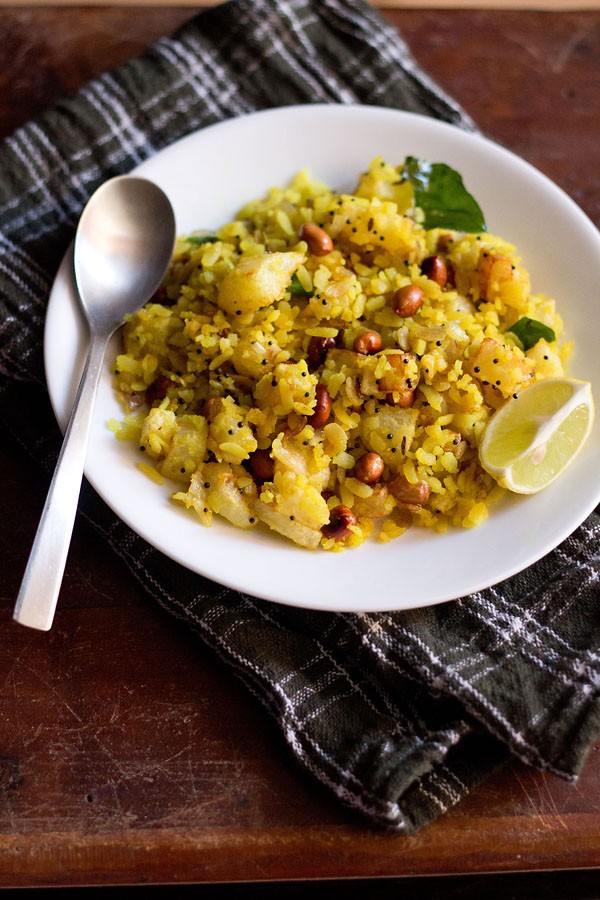
Here, I have posted my mother’s version of making this recipe. I have had this dish at many places in Mumbai. But I like it the way my mom makes.
Her recipe of making this dish is too good. So, I too follow her recipe only for making it at my home.
This recipe is slightly different from the regular version of making the same and that is instead of using boiled potatoes, I pan-fry or sauté the batata or potatoes first.
This adds a crispy texture along with the crunchiness of the roasted peanuts. The lovely fried potatoes along with the other crunchy elements like the peanuts, onions and spices makes this recipe highly flavorful.
It is so comforting and satisfying at the same time that you may also want to turn it into a lunch or dinner meal as well.
I also add grated fresh coconut at times. But it’s entirely optional. If you have coconut, well and good and if you do not have coconut, then too the dish will be just as fine. In short, this Aloo Poha tastes great even without the coconut.
If you, like me, enjoy having poha for breakfast, do check out Indori Poha – a specialty from Indore, Chura Matar – a unique snack from Uttar Pradesh, and Aval Upma – a delightful South Indian breakfast made with flattened rice.
How to make Batata Poha
Roast Peanuts
1. Heat a pan and add 2 tablespoons peanuts.
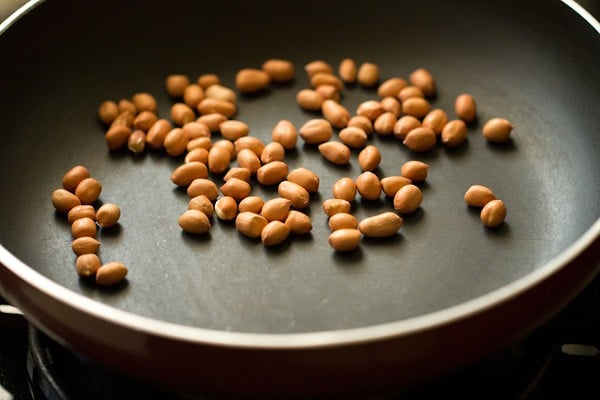
2. Roast the peanuts on medium-low to medium heat until they become crunchy and set aside.
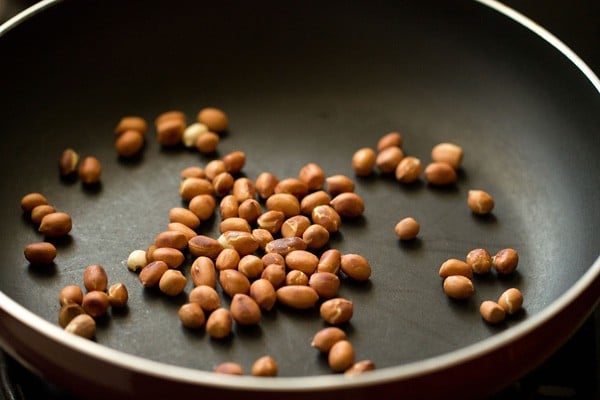
Prepare Poha Mixture
3. Pick 1½ cups of the flattened rice and rinse it in clean running water twice or thrice. Use a strainer to rinse it. Make sure that you do not rinse it too much or else it breaks and gets mushy.
While rinsing, the flattened rice flakes absorbs enough water and it becomes soft. The poha must become soft but remain intact, whole and separate.
If the flattened rice does not become soft, sprinkle few drops of water on the the flakes in the strainer.
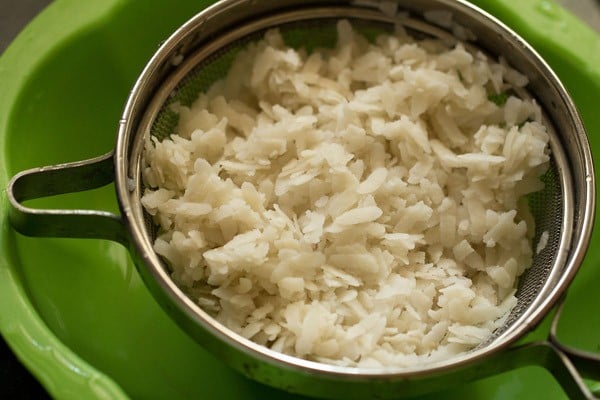
4. Sprinkle ½ teaspoon turmeric powder, 1 teaspoon sugar and salt as required.
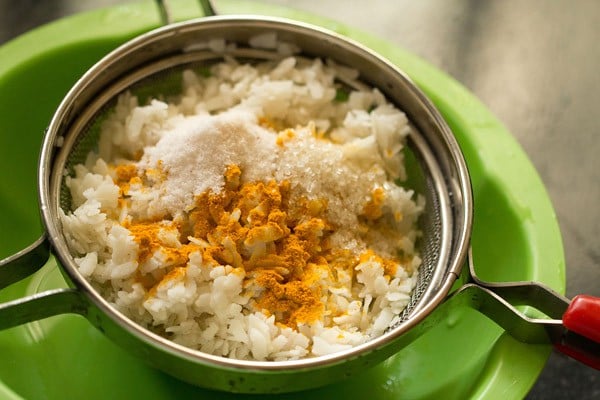
5. Gently mix with your hands.
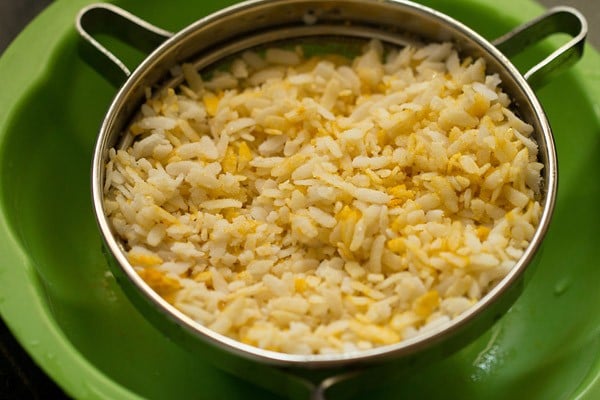
Sauté Potatoes
6. Heat 2 tablespoons oil in a pan or kadai.
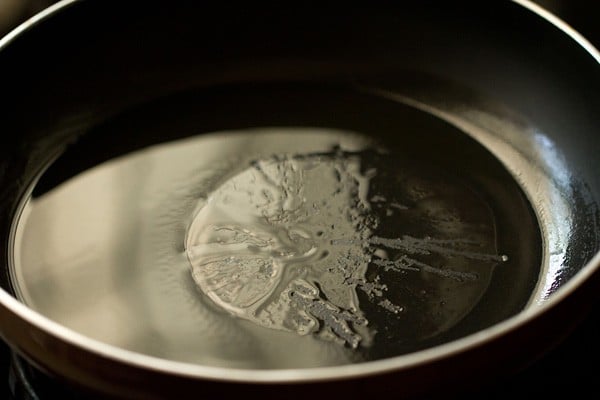
7. Add 1 large potato, peeled and chopped into ½ inch small cubes, in the pan.
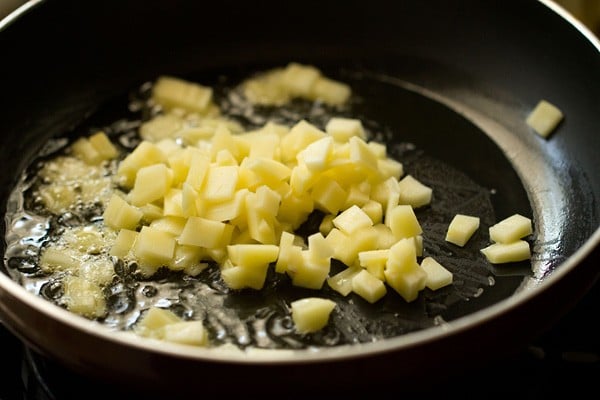
8. Sauté the potatoes till light golden and crisp.
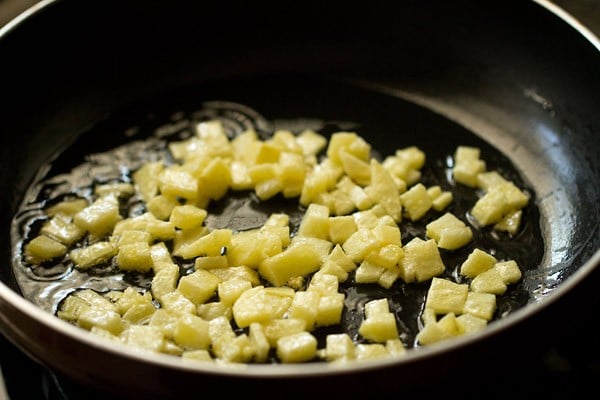
9. Remove them with a slotted spoon and keep aside.
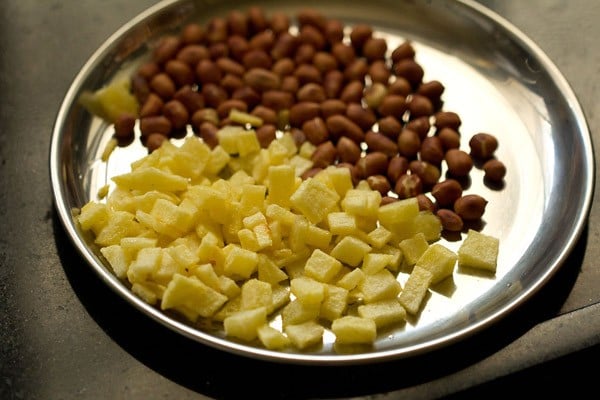
Sauté Spices, Onions & Green Chilies
10. In the same pan or kadai, lower the heat. Then, add 1 teaspoon mustard seeds to the hot oil. When they splutter, add the 1 teaspoon cumin seeds.
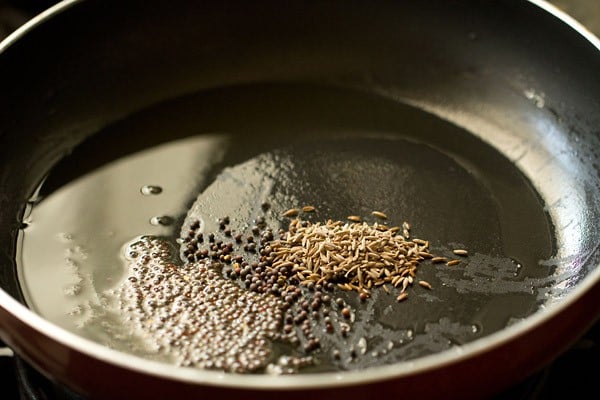
11. Allow the cumin seeds to change the color and crackle.
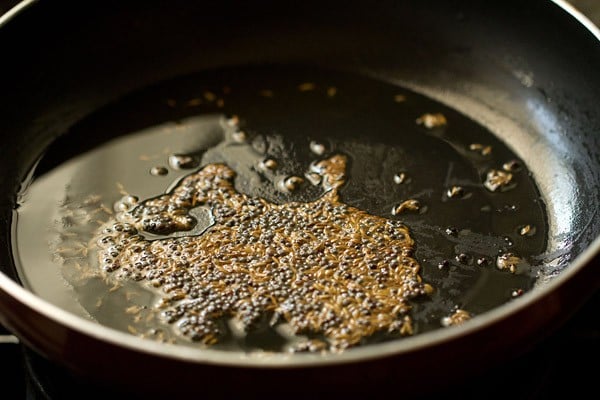
12. Then, add about ½ cup finely chopped onions.
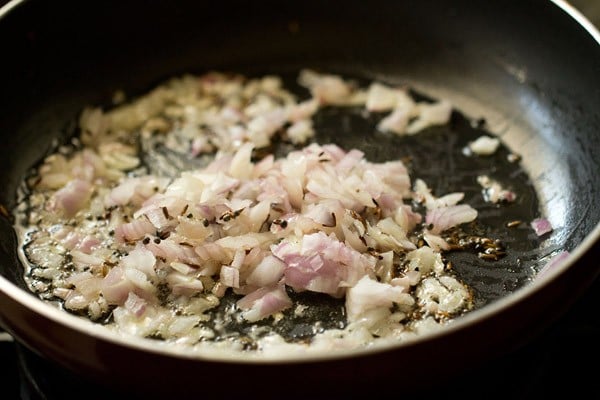
13. Sauté the onions until they turn translucent and soften.
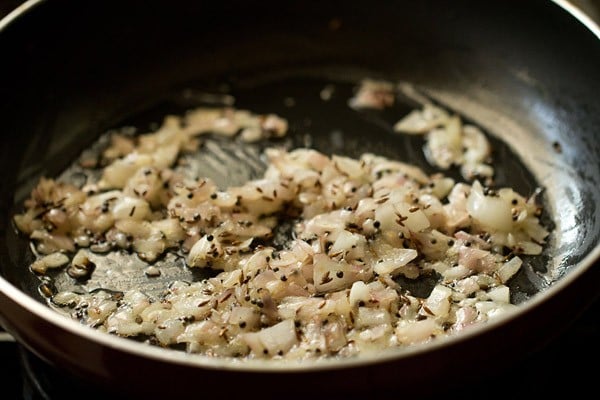
14. Now, add 7 to 8 curry leaves, 1 teaspoon chopped green chilies, sauté for half a minute.
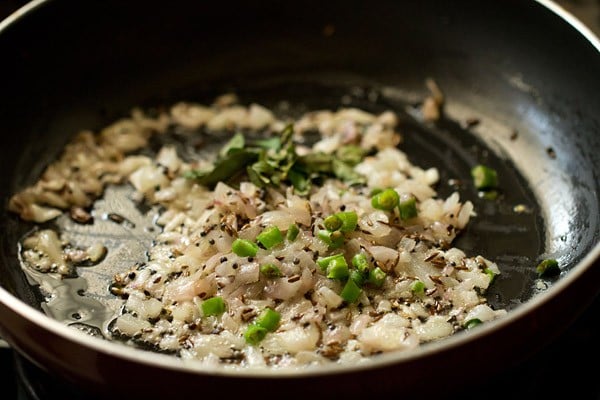
15. Add the roasted peanuts and mix well.
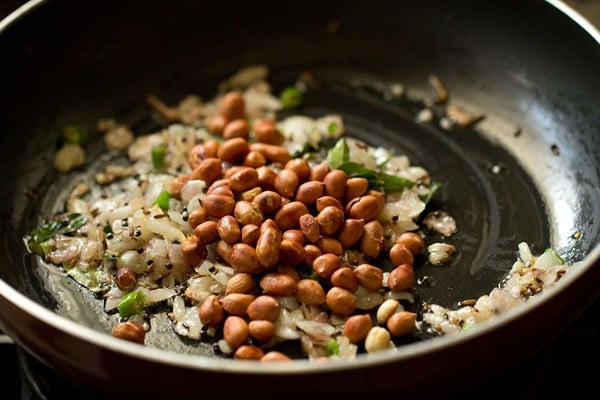
Make Batata Poha
16. Add the prepared poha mixture.
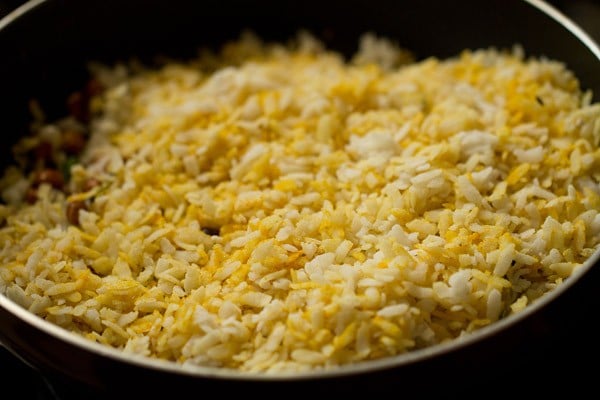
17. Stir gently but very well till everything is mixed evenly.
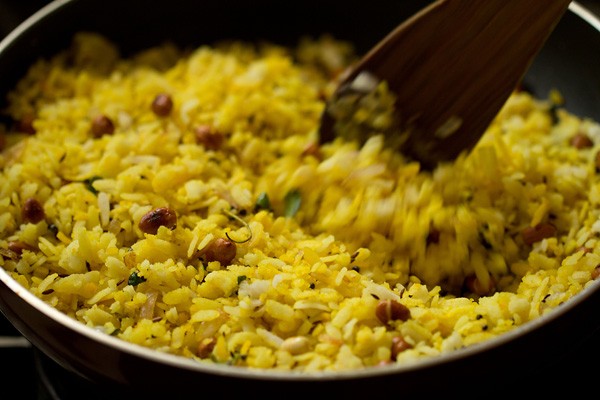
18. Next, add the sautéed potatoes. Again, mix gently with the rest of the mixture. Check the taste and add more of the salt or sugar, if required.
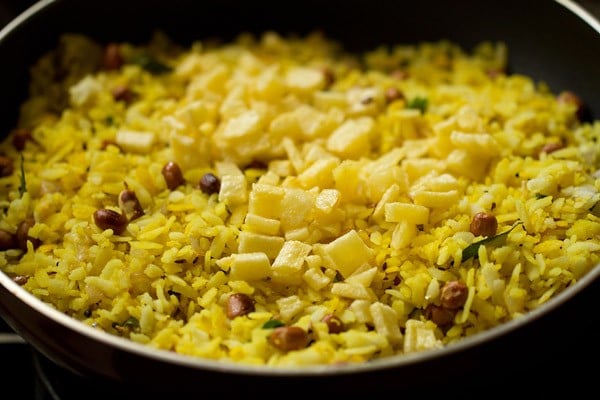
19. Cover the pan tightly with a lid and steam the poha for a minute or two on low heat. This method softens the flattened rice.
Turn off the heat and keep the pan covered for 4 to 5 minutes more.
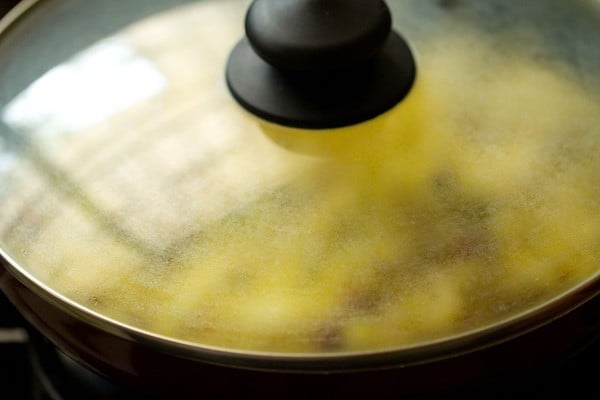
20. Remove the lid. Batata Poha is ready to be served now. You can also garnish with chopped coriander leaves and grated fresh coconut.
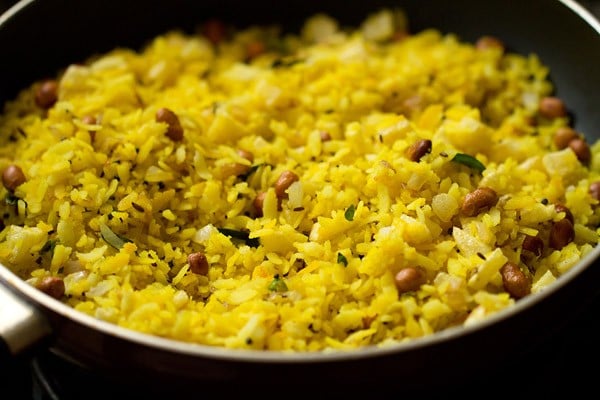
21. Serve Batata Poha with chopped lemon pieces. The lemon juice has to be squeezed on to the poha before eating it.
Alternatively, you can also do this method. Once the poha is done, sprinkle about 1 teaspoon lemon juice on it. Mix it and then garnish with coconut and coriander leaves.
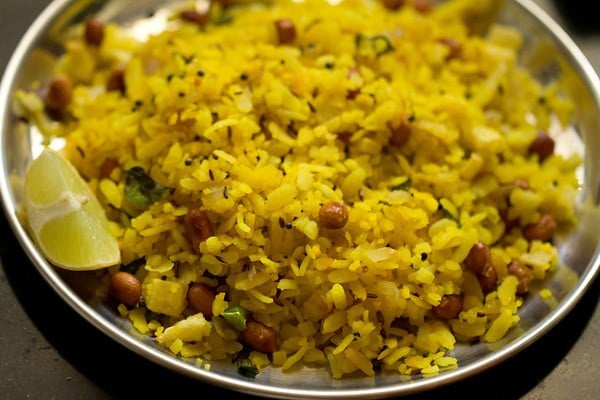
22. While serving, garnish with a fresh sprinkling of chopped coriander leaves. Serve Batata Poha hot or warm. You can also pair it with Masala Chai.
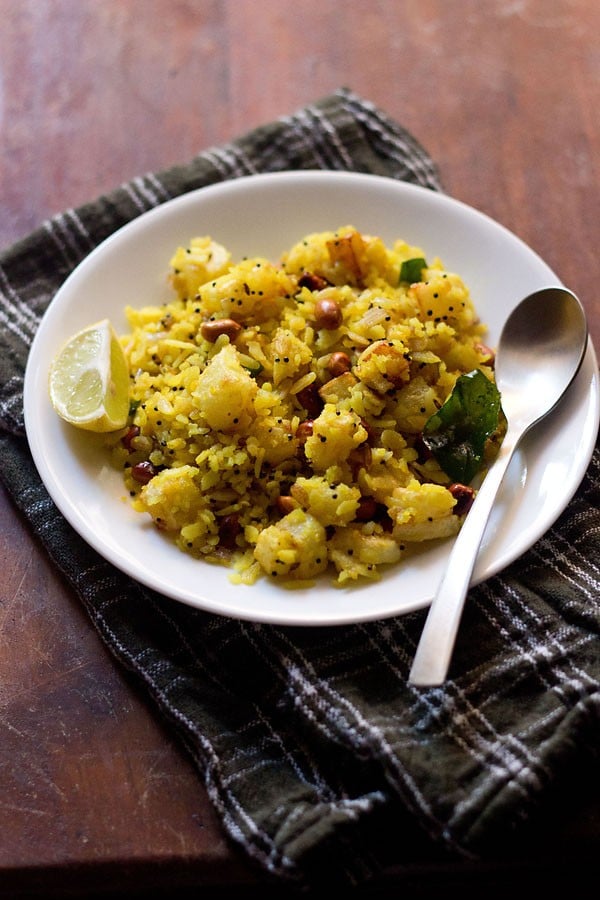
Expert Tips
- Variety of poha: Use thick or medium-thick poha (flattened rice) for this recipe. Thin flattened rice turns mushy when cooked. You could also use brown or red flattened rice.
- Rinse poha properly: Use a colander to rinse the flattened rice in running water. This will remove extra starch. Gently toss it with your fingers to ensure even rinsing without breaking the rice flakes.
- Preparation of potatoes: Peel and dice the potatoes into small cubes. You can either boil them or directly sauté them in the pan until they are lightly golden and cooked through.
- Season right: Adjust the seasoning by adding salt, sugar, and/or lemon juice according to your taste preferences. Mixing well helps to distribute the flavors evenly in the dish.
- Garnish options: Garnish the poha with fresh coriander leaves, grated coconut or even finely chopped onions or sev for added flavor and texture.
Step by Step Photo Guide Above
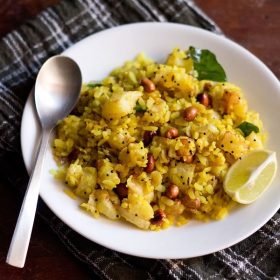
Maharashtrian Batata Poha (Aloo Poha)
Ingredients
To Prep Poha
- 1.5 cups poha – thick or medium-thick variety, (flattened rice, parched rice)
- ½ teaspoon turmeric powder
- 1 teaspoon sugar or add more if you want the poha to be more sweet
- salt as required
More Ingredients
- 1.5 to 2 tablespoon peanuts
- 2 to 2.5 tablespoons oil
- ⅔ to ¾ cup potato – or 1 medium to large-sized, peeled and cut in ½ inch cubes, (aloo or batata)
- 1 teaspoon mustard seeds
- 1 teaspoon cumin seeds
- ½ cup onions – finely chopped or 1 small to medium-sized onion
- 1 green chili – finely chopped
- 1 sprig curry leaves about 8 to 10 curry leaves
- 2 to 3 tablespoons coconut – grated and fresh, optional
- 1 to 2 tablespoons coriander leaves – chopped, (cilantro)
- 1 lemon cut in wedges or 1 teaspoon lemon juice or add as required
Instructions
Preparation
- Heat up a frying pan and add the peanuts.
- Roast the peanuts on medium-low to medium heat until they become crunchy. Set the roasted peanuts aside.
- Pick the flattened rice flakes first of any stones or debris. Rinse the flattened rice flakes in clean running water twice or thrice.
- Use a strainer to rinse the flattened rice flakes. Keep them in the strainer and rinse them in running water.
- Make sure that you do not rinse the rice flakes too much or else they break and gets mushy. While rinsing, the flakes absorbs enough water and they become soft.
- The rice flakes must become soft but remain intact, whole and separate. If the flattened rice flakes do not become soft, sprinkle few drops of water on them in the strainer.
- Sprinkle turmeric powder, sugar and salt (as required). Gently mix with clean fingers.
Making batata poha
- Heat oil in a pan or kadai. Add the potato cubes.
- Sauté the potatoes stirring often until the potatoes are tender and look light golden and crispy.
- Remove the sautéed potatoes with a slotted spoon and set aside.
- In the same pan or kadai, add the mustard seeds to the hot oil.
- When they splutter, add the cumin seeds. Allow the cumin seeds to change the color and crackle.
- Add the finely chopped onions.
- Sauté the onions until they become translucent and soften.
- Now add the the curry leaves and chopped green chilies. Sauté for half a minute.
- Add the roasted peanuts and mix well.
- Add the prepared poha. Stir gently but very well till everything is mixed evenly.
- Then add the sautéed potatoes. Again mix gently with the rest of the mixture.
- Cover the pan tightly with a lid and steam Batata Poha for a minute or two on a low heat.
- This method softens the rice flakes. Turn off the heat and keep the lid covered on the pan for a further 4 to 5 minutes.
- Remove the lid and garnish with chopped coriander leaves and grated fresh coconut.
- Serve Aloo Poha hot with chopped lemon wedges. The lemon juice has to be squeezed on the poha before eating it.
- Alternatively, once the Batata Poha is done, sprinkle about 1 teaspoon of lemon juice on it and mix. Later garnish it with grated coconut (optional) and coriander leaves.
- Serve Batata Poha hot or warm garnished with coriander leaves. You can also sprinkle some sev if you like.
Notes
- Adding sugar is optional. You can skip it completely if you don’t prefer a slightly sweet taste in your Aloo Poha.
- For a more spicy taste, add more green chillies.
- Grated coconut can be skipped completely from the recipe.
- You could also boil or steam the potatoes instead of pan frying them.
- The recipe can be made with brown as well as red rice flattened flakes. If either of these varieties do not soften after rinsing in water, soak them in water for some minutes until they soften.
Nutrition
This Batata Poha from the archives was first published on July 2010.

Can I make this without the onions?
Onions add a nice flavor and soft crunch. But if you are looking for no onion version, you could skip it; but do add a generous pinch of asafoetida, to the oil while tempering or sautéing, to mimic the flavor of the onions.